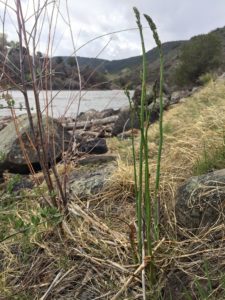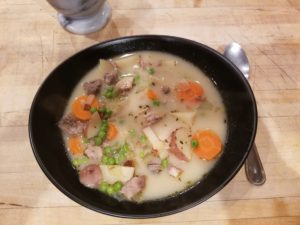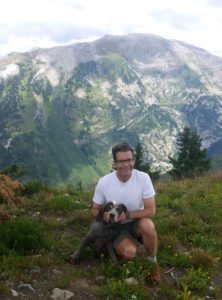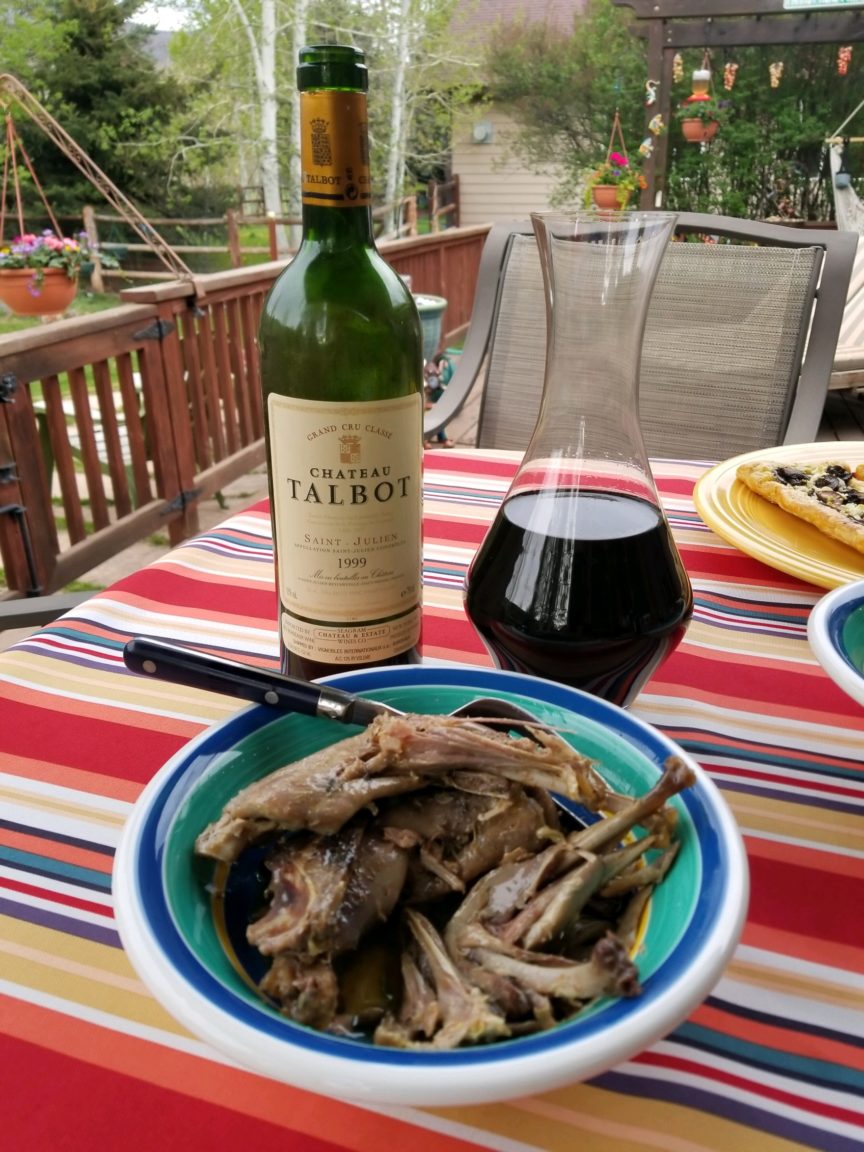What is divinity if it can come
Only in silent shadows and in dreams?
Shall she not find in comforts of the sun,
In pungent fruit and bright green wings, or else
In any balm or beauty of the earth,
Things to be cherished like the thought of heaven?
(Wallace Stevens, “Sunday Morning”)
MAXIMUM pleasure:
On Morels, Pheasant & Fruit of the Vine
An ongoing feature by the one, the only, Maxwell

Plants are bio-sponges; harvest asparagus from healthy soils and in clean drainages. A lot of the roadside stuff? Not so great! Anglers snacked on this pungent patch on the lower Roaring Fork River, leaving stalks to sustain perennial roots. Photo, Editor GJV
It is spring, and the wild asparagus has emerged in fields and ditches throughout the valley to herald the riotous growth of summer. Hopefully, morel mushrooms will appear soon in that celebration. My friend JF whispered to me last week where the fertile morel grounds lie—the first saturating rainfall will drive us out to harvest some for dainty eating. Meanwhile, the dandelion crop all over provides salad greens and golden color for dull winter eyes. I’m craving all the edible things that grow from the soil, swim in lakes and streams, fly, or run. As if prompted by nature herself, I took three plump Ring-necked Pheasants out of my freezer two days ago. They were left in their handsome plumage to protect the flesh from freezer burn. While they are thawing, I stare at the copper, orange, brown, red, black, green, and white feathers and remember the halcyon autumn day when I shot them. If I have the time tomorrow, I’ll make confit from the sinewy legs and soup from the dark breasts.
Wine Pairings
I am craving wine too, wine for the asparagus, for the morels I long to find, wine for the dandelion salad, and wine for both pheasant preparations a day or two from now. For the asparagus, Sancerre from the Loire Valley is the classic companion for the tender stalk’s pungency. Pouilly-Fume, another Sauvignon Blanc from right next door in the Nievre département, would be exciting, but both can be expensive. Fine examples of modestly priced Touraine, also Sauvignon Blanc, can provide loads of juicy, lip-smacking Sauvignon character, but typically without the legendary “flintiness,” smokiness, and power of its famous cousins. Honestly, however, any decent Sauvignon from around the world–Austria’s Styria, the western cape of South Africa, Chile, the Adelaide Hills of Australia, Hawke’s Bay in New Zealand, and the Collio region of Friuli-Venezia Giulia all come to mind—can intensify the flavors of this delicacy.
I haven’t carefully tested brewed beverages with wild asparagus yet, but my hunch is that fresher, more citric pilsners and lagers might work well. There are many excellent examples from local breweries to work with in this way. A light, fine IPA and a Saison would be fun to taste as well to see if they are fit companions for the asparagus. There are so many fun places in this area to sip beer these days that I see a rich potential for additional research on this front.
Finally, I must mention sherry. Americans don’t drink much of this sublime wine from Spain, thinking it is a cloying, sweet tipple grandmother used to enjoy. It’s true, sherry can be sweet, even decadently so, but it can also be bone-dry, with a fresh, slightly salty, minerally flavor. This latter, dry, variety (it’s called Manzanilla) will certainly be on the table.

Photo info top secret; those darn mushroom people
The wine for the morels is less determinate. To some extent, how I prepare the mushrooms dictates what must accompany them. For me, the forest flavors of this precious fungus invite the swaddling influences of butter, cream, sherry, pasta, and charcuterie. For drinking, that means red wine which will serve as a foil to, or will combine with, the nutty, woodsy aromas and flavors while also penetrating the fat used with the mushrooms. To find a foil to the food, I’m thinking about Gamay-derived wines like Cru Beaujolais. They can possess a juiciness and bright, cheerful fruitiness that would contrast with the earthy flavors of the food. Grenache from McLaren Vale or the Barossa Valley in Australia, not to mention the strawberry or cherry-laced aromas and flavors of a Pinot Noir from California, could create a similar kind of contrast. I’m thinking also about Nebbiolo and French country wines like Corbieres, Minervois, Faugeres, or Cotes du Roussillon. With their earthier characters, they would combine with the woodsiness of the mushrooms and create a heartwarming likeness of flavor. A brown ale, or a beer with a hint of brettanomyces, could achieve a similar effect.

Pheasant chowder recipe, courtesy of Javier Gonzalez-Bringas. Photo, Maxwell
And the pheasant, well, you may drop by with any powerful red wine that you enjoy drinking and sit on the porch with me, for the possibilities are myriad. With their dark meat and assertive flavors, aged game birds defy most attempts to overpower them. The birds’ rustic, savory aromas and flavors complement the earthiness of Spanish and French reds like Rioja, Ribera del Duero, Bordeaux, and Burgundy, but, at the same time, are also appealing against the fruitiness of New World wines like Syrah, Petite Sirah, Zinfandel, and Pinot Noir.
Colorado Wines
Colorado is now a significant wine growing region in the U.S. and no doubt is on your mind when you are shopping. Many of our emerging vineyard plantations (some of the best ones are just over McClure Pass toward Paonia) resemble the great vineyards of France, Argentina, and Spain, and are producing wines of convincing flavor authority. After gathering my morels, perhaps I’ll drop over to the North Fork on the other side and pick up some Tempranillo or a Bordeaux from Hotchkiss to make my meal of truly local derivation.

Maxwell and Spanish Pointer Madrid. She is known to sniff up a bird or two. Photo, Clara Maxwell
For the past twenty-three years, I’ve worked in the wine importing and distribution business. Visiting vineyards and wineries in the various wine-growing regions of the world, I make arrangements for the bottling, labeling, packaging, and shipping of wines I bring to market. These multi-faceted commercial activities have given me a valuable education I could have acquired in no other way. The majority of my studies unfolded in California. There, in that place, and with access to nearly every bottled wine known to humankind, I learned to savor the fruit of the vine.

